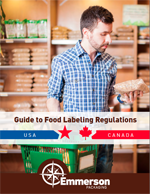New GMO Labeling Rules: USA vs Canada
October 5, 2016
If you manufacture or distribute food products in both the United States and Canada, navigating different regulations for GMO labeling can be frustrating. Until recently, some manufacturers simply didn’t sell their products in states with strict GMO labeling rules, as across-the-board compliance with varying state regulations was difficult. Now, new federal rules have set a single standard for the United States, and GMO labeling rules remain the same in Canada.

GMO Labeling Rules in the United States
President Obama signed Bill 764 in July 2016, creating a new federal standard in the USA for GMO labeling rules and overriding preexisting state laws—including the particularly strict laws in Vermont which had come into effect just a few weeks prior. Bill 764 amended the Agricultural Marketing Act of 1946 and created new GMO labeling obligations for food manufacturers who intend to sell their products in any part of the United States.
The new GMO labeling rules are fairly controversial, earning criticism from both pro- and anti-GMO groups. Much of the controversy arises from the way in which GMO food content can be indicated on a food label.
Unlike (for example) allergen statements, GMO ingredients do not have to be explicitly mentioned on a food label. Instead, the manufacturer can opt to direct the consumer to an external source to receive information about the GMO status of the product, including a website URL, phone number, or a scannable QR code.
The federally mandated obligation to report GMO ingredients means that manufacturers must now obtain assurances (via certificates of analysis, etc.) from their suppliers that all ingredients are non-GMO, which some manufacturers say will be costly.
GMO Labeling Rules in Canada
In Canada, there is no regulatory requirement from either Health Canada or the Canadian Food Inspection Agency to label GMO ingredients. Manufacturers may voluntarily disclose the GMO status of their product, subject to various regulations.
A product in Canada claiming non-GMO status must ensure that all ingredients in a multi-ingredient product are not a product of genetic engineering, must contain supporting information on the label, and cannot use absolute descriptive terms such as “free”, “100%”, or “all”. Canadian manufacturers also cannot make a non-GMO claim with regard to any food product for which there is not a GMO-containing alternative already commercially available.
Voluntary non-GMO label claims in Canada are subject to other regulations which can be found here.
Food Labeling Rules in Canada and the USA
For more key differences between food labeling rules in the United States and Canada—including an overview of the latest NLEA label designs—download our FREE Guide to Food Labeling Rules now!


